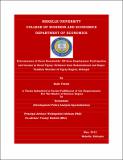| dc.description.abstract | This study examines the determinants of off-farm employment participation and income of
rural households in rural Tigray, using evidence from Endamokonni and Degua Tembien
Woredas of Tigray region, Northern Ethiopia.
Results are based on data collected from a survey of 205 randomly selected rural
households. Both bivariate probit and univariate probit models are used to estimate the
off-farm wage and off-farm self employment participation. Given participation, the
factors that affect per capita off-farm employment income are analyzed using two step
Heckman selection model. This considers for possible self selection in the estimation
procedure.
Age and formal education of the household head, number of children with 10 years old or
under and district where the households live significantly affects participation in off-farm
wage work. On the contrary, participation in off-farm self employment is strongly
determined by sex of the household head, number of adult male in the household, per
capita non labor income, credit use, per capita livestock holding, district and distance to
the nearest all weather road and distance to the nearest major market.
Households with large farm size, informally educated heads and those who live in
Endamokonni Woreda earn significantly higher income from wage work. Households
with older heads, more adult males, more children with five years old or under, higher
livestock holding and those who live far-off from major market earns lower off-farm
wage income, in case they participate. Given participation, male headed families earn
higher income from off-farm self employment than the female headed counterparts.
Number of adult male and children with six to ten years old in the family negatively and
significantly relates with the level of per capita self employment income. This may be
because off-farm self employment income is expressed in per capita terms. | en_GB |


